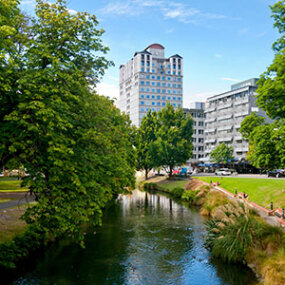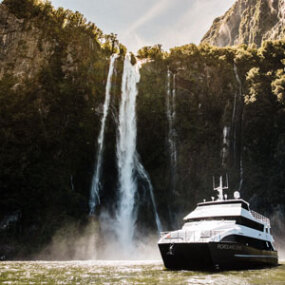Browse other blog categories
- City Experiences (8)
- Articles of Interest (16)
- The Best of New Zealand (26)
- Luxury New Zealand (4)
- South Island Touring (22)
- North Island Touring (13)
- Essential Info (19)
- LOTR, Middle Earth & Hobbits (5)
- Cultural Experiences (8)
- Scenic Trains, Flights & Tours (6)
- Adventure Travel (14)
- Walking, Hiking & Biking (15)
- Family Holidays (10)
- Things to Do (17)
- National Parks & Wildlife (20)
- Food & Wine Experiences (7)
Guide to New Zealand Weather & Climate
New Zealand Climate
Since the Maori people named New Zealand, ‘The Land of the Long White Cloud’ / Aotearoa, the climate has been of paramount importance to the people of New Zealand – many of whom make their living from the land. New Zealand has mild temperatures, moderately high rainfall, and many hours of sunshine throughout the country. Its climate is dominated by two main geographical features: the mountains and the sea.
Temperature
New Zealand has a largely temperate climate. While the far North has subtropical weather during summer, and inland alpine areas of the South Island can be as cold as – 10°C in winter, most of the country lies close to the coast, which means mild temperatures, moderate rainfall, and abundant sunshine.
Because New Zealand lies in the Southern Hemisphere, the average temperature decreases as you travel South. The far North of the country has an average temperature of about 15°C, while the deep south has a cooler 9°C average. January and February are the warmest months of the year, and July is the coldest.
Four Seasons in One Day
New Zealand does not have a large temperature range, lacking the extremes one finds in most continental climates. However, the weather can change unexpectedly – as cold fronts or tropical cyclones quickly blow in. Be prepared for sudden changes in weather and temperature if you’re going hiking or doing other outdoor activities.
Sunshine
Most places in New Zealand receive over 2000 hours of sunshine a year, with the sunniest areas — Bay of Plenty, Hawke's Bay and Nelson/Marlborough – receiving over 2350 hours. As New Zealand observes daylight saving, during the summer months daylight can last up until 10.00 pm. New Zealand experiences relatively little air pollution compared to many other countries, which makes the UV rays in our sunlight very strong during the summer months. In order to avoid sunburn, visitors should wear sunscreen, sunglasses, and hats when they are in direct summer sunlight, especially in the heat of the day (11am - 4pm). While summer is sunnier than the other seasons, most regions in New Zealand have a relatively high proportion of sunlight during the winter months.
The highest temperature ever recorded in New Zealand was 42°C, in Marlborough, Christchurch, and Rangiora (in Canterbury). The lowest temperature ever recorded in New Zealand was – 22°C at Ophir, Central Otago.
Rainfall
New Zealand’s average rainfall is high – between 640mm and 1500mm – and evenly spread throughout the year. As well as producing areas of stunning native forest, this high rainfall makes New Zealand an ideal place for farming and horticulture.
Summer
New Zealand’s summer months are December to February, bringing high temperatures and sunshine. Days are long and sunny, nights are mild. Summer is an excellent time for walking in the bush and a variety of other outdoor activities. New Zealand’s many gorgeous beaches are ideal for swimming, sunbathing, surfing, boating, and water sports during summer. Queenstown in particular (South Island) is frequently termed the adventure capital of the world. This location is particularly popular in summer with a vast range of activities.
Why not explore our popular summer beach & bay tour?
Autumn
March to May are New Zealand’s autumn months. While temperatures are a little cooler than summer, the weather can be excellent, and it is possible to swim in some places until April. While New Zealand’s native flora is evergreen, there are many introduced deciduous trees. Colourful changing leaves make autumn a scenic delight, especially in regions such as Central Otago and Hawke’s Bay, which are known for their autumn splendour.
Check out our 4 day Glacier, Queenstown and Milford Sound tour including the Gibbston for a beautiful Autumn escape.
Winter
New Zealand’s winter months of June to August bring colder weather to much of the country, and more rain to most areas in the North Island. Mountain ranges in both islands become snow-covered, providing beautiful vistas and excellent skiing. Discover Wanaka's Cardrona & Treble Cone or Queenstown's Remarkables & Coronet Peak in the South Island. While the South Island has cooler winter temperatures, some areas of the island experience little rainfall in winter, so this is an excellent time to visit glaciers, mountains, and other areas of scenic beauty.
Did you know... we have a sister ski brand. Click here to see our wonderful winter ski and activity packages.
Spring
Spring lasts from September to November, and New Zealand’s spring weather can range from cold and frosty to warm and hot. During spring buds, blossoms, and other new growth burst forth throughout the country and newborn lambs frolic in the fields just before dusk. Both Alexandra in Central Otago and Hastings in Hawke’s Bay celebrate spring with a blossom festival. If you’re into white water rafting, this is the time when melting spring snow makes river water levels excitingly high!
If sulphur geothermal hot pools and wineries appeal to you, see this trip.
Remember we can customise ANY itinerary for you, whether it's style, activity, accommodation or price!
Categories:
- Essential Info
Published on: 25 May 2017, Written by: David Kettle
We have lots more information to share with you if you need it. Our team lives and works within New Zealand. We have travelled to every region and experienced the best (and worst) of what there is to offer. If you have any questions about tours, locations or just want some friendly advice please reach out to us by chat, email, or phone. There is no penalty for getting in touch, we do NOT charge any consultant fees so you can take the hassle out of your travels for free!
If you are interested in planning a trip then please leave your details in the simple form below and we can provide you with support customising a tour just for you.




